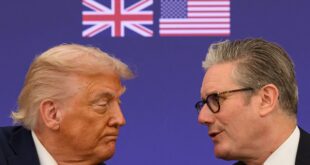Did America Wait Too Long to Counter China?
During the past two decades, many American leaders have argued that U.S. foreign policy must focus more on Asia. In 2009, Secretary of State Henry Kissinger said that “the center of gravity of international affairs is importantly shifting from the Atlantic to the Pacific and Indian Oceans.” In 2011, Secretary of State Hillary Clinton announced that the United States would “pivot to Asia” after having devoted too many resources to other areas of the world, particularly Afghanistan and the Middle East. And in 2022, President Joe Biden said that “the future of the twenty-first-century economy is going to be largely written in the Indo-Pacific.”
By any metric, Asia is the world’s most strategically important region today. It is home to over half the world’s population and boasts six of the world’s 25 largest economies, 14 of its 25 biggest militaries, and four of the nine countries with nuclear weapons. Asian-Pacific states have been engines of worldwide growth, accounting for over 70 percent of the increase in global GDP over the last decade; China alone has contributed a staggering 31 percent. The region hosts 19 of the top 100 universities, according to the Times Higher Education’s ranking, and ten of the 25 countries that filed the most patents in 2021. If the United States wants to remain the planet’s most powerful country, it will have to tap into Asia and prevent China from dominating it.
But as Robert Blackwill and Richard Fontaine demonstrate in their insightful new book, Lost Decade, the United States has repeatedly failed to achieve its promised shift. The efforts of successive administrations to complete the pivot, they write, have “foundered on the shoals of execution.” The United States has continued to allocate more military resources and pay more attention to the Middle East and Europe. Despite its sporadic attempts to engage more deeply with Asian countries, Washington did not coherently respond to China’s growing power in the second decade of this century. Blackwill and Fontaine soberly conclude that this is “perhaps the most consequential” U.S. policy failure since 1945.
The book helpfully describes the obstacles that lie ahead for any American president hoping to prioritize Asia. But the authors overlook some of the obstacles to their own recommendations and stop short of explaining what should happen once the United States does shift its resources to the region. Countering China requires more than just a pivot. Washington must mobilize, including by stocking more of the right weapons and gaining increased military access to China’s neighbors. Only then will the United States be able to deter Chinese aggression, strengthen its presence in Asia, and safeguard its interests in the region.
SLOW TO SHIFT
When the Obama administration declared that it would pivot toward Asia, the idea was to draw down U.S. involvement in the Middle East and curtail defense spending in Europe so that Washington could focus on spurring economic growth in Asia and countering China’s expanding influence. That would require the United States to spearhead the massive free-trade deal known as the Trans-Pacific Partnership, move weapons and personnel to the Indo-Pacific, stock up on equipment suitable for a war with China, and intensify diplomacy in Asia. The pivot won bipartisan support and was embraced by successive administrations because there was already a consensus in Washington that the United States had misallocated its assets, favoring regions of waning importance.
And yet as Lost Decade illustrates, U.S. policymakers were slow to execute the shift and suffered the consequences of missteps in Asia policy that long predated the pivot. President Bill Clinton, for example, supported China’s entry into the World Trade Organization in 2001 based on the belief that economic interdependence would encourage China to liberalize and moderate its foreign policy ambitions. Yet that assumption proved faulty because China’s views about how to build and exercise power were different than those of the United States. President George W. Bush strengthened security alliances in Asia by ramping up military cooperation with Singapore, relocating military bases in Japan to reduce political friction with Tokyo, and participating in the first quadrilateral military exercise with Australia, India, and Japan. But his administration was distracted by conflicts in the Middle East and the “war on terror” and ultimately failed to devote more resources and attention to Asia.
President Barack Obama and his top advisers recognized these failures and announced a pivot to Asia in part to make up for lost time. But their goals lacked clarity, and they did not thoroughly plan new policies, analyze their costs and benefits, consider alternative scenarios, or consult with allies. The result was a strategy that often seemed contradictory, caught between the need to assert a strong presence in Asia and the obligation to respond to emerging threats, such as Russia’s aggression toward its neighbors and instability in the Middle East. And even when Obama seemed to pivot, the effort fell short. For example, his administration announced in 2012 that it would base 60 percent of the U.S. naval fleet in the Asia-Pacific by 2020. But 60 percent was not enough to deter the growing Chinese navy, especially because many of those assigned vessels were to remain docked in California or Hawaii—far from the hot spots of potential conflict.
On the surface, Asia policy under President Donald Trump appeared more consistent, rooted firmly in competition rather than cooperation. Trump abandoned efforts to shape Chinese behavior and gave up on joining multilateral trade agreements, as with the Trans-Pacific Partnership in 2017. Instead, he adopted a confrontational stance toward Beijing; he sanctioned Chinese officials and companies and worked to shrink bilateral trade deficits. But Trump’s approach was also riddled with contradictions. He threatened, for example, to withdraw troops from Japan and South Korea unless they paid more for U.S. military presence, undermining Washington’s alliances with those countries by casting doubt on the depth of its commitment.
Such actions left U.S. allies uncertain about their standing with the United States. When Biden came into office in 2021, he tried to reassure these jittery partners while also maintaining his predecessor’s assertive posture toward Beijing. He poured money into Taiwan’s defense capabilities through the Pacific Deterrence Initiative and Taiwan Enhanced Resilience Act. And he increased cooperation with Australia, Japan, and the Philippines. But his attention has been diverted by Russia’s invasion of Ukraine and the Israel-Hamas war, further delaying investment in new defense capabilities suited for deterring China.
REASONS OR EXCUSES?
Blackwill and Fontaine offer a variety of explanations for why so many presidents have so thoroughly failed to carry out a proper pivot: redirecting attention to Asia would have yielded them “no domestic political benefit”; despite many proclamations about the importance of shifting attention to Asia, there was never a clear catalyst for doing so; U.S. policymakers did not have a common understanding of what the pivot would entail and underestimated the challenge posed by China’s rise.
This analysis is mostly persuasive, but in many ways, the authors are too generous in their assessment of Washington. They excuse inaction by arguing that passing the Trans-Pacific Partnership “would have put members of Congress in the crosshairs of anti-trade voters.” They point out that moving military assets away from Europe and the Middle East could have undermined U.S. credibility in those regions. And they hold that Washington failed to give Asia its due because U.S. policymakers were “drawn to crises in other regions.”
It is true that U.S. leaders have been overstretched. But they have also been either unable to think creatively about different approaches or unwilling to take the risks necessary to ensure the pivot succeeds. For example, individual officials have often appeared to be too focused on careerist objectives, such as advancing to a coveted job or getting reelected, to gamble on unconventional China policies; better to stick with the status quo, they often seem to conclude. U.S. administrations have also tended to focus their diplomatic efforts on the developed world instead of on poorer countries, leaving a vacuum for Beijing to fill. Take the Solomon Islands. The United States shuttered its embassy there between 1993 and 2023, allowing China to make inroads in one of the poorest countries in the Pacific. In 2022, China and the Solomon Islands signed a security pact, which—according to a leaked draft of the deal—lets Chinese naval vessels resupply on the islands.
An important obstacle to pivoting the authors gloss over is the internal disagreement among U.S. policymakers as to the nature and timing of China’s threat and how to respond to it. Hawks, for example, see a Chinese invasion of Taiwan as imminent and favor a more proactive approach to defending the island, whereas doves discount that possibility and fear that an enhanced U.S. military presence might precipitate the very war it is trying to deter. Even Defense Department officials who agree that China poses a military threat disagree on whether the United States should prioritize near-term readiness or long-term modernization.
THE FULL 180
Blackwill and Fontaine offer a long to-do list for completing the shift to Asia. It includes continuing to strengthen U.S. alliances in the Indo-Pacific, joining the Comprehensive and Progressive Agreement for Trans-Pacific Partnership (the trade deal that emerged after Washington pulled out of the Trans-Pacific Partnership), “de-risking” economic ties with China, substantially increasing defense production, and moving U.S. military assets and personnel from Europe and the Middle East to the Indo-Pacific. They want Washington to garner more European support in the fight against China—for example, by encouraging allies to create joint standards for technology, cybersecurity, and human rights. The authors also suggest that the United States build coalitions with allies centered on specific issues, such as preventing economic coercion and intellectual property theft. At the same time, Blackwill and Fontaine call for intensifying bilateral U.S.-Chinese diplomacy by adhering to the “one China” policy, which acknowledges China’s belief that there is one China and Taiwan is a part of it, and by keeping open communications channels with Beijing. Finally, the authors recommend that Washington “support the forces of democracy and liberalism” by defending democratic institutions under pressure across the globe and fostering them in regions where they do not yet exist.
Many of these suggestions would help manage China’s rise, but they are not enough. For example, the United States needs not only to manufacture more military equipment but also to be smarter about what it produces. It needs weapons that can help maintain air dominance, conduct interdiction operations, defend against air and missile threats, and destroy hard targets buried deep underground. It should stockpile long-range antiship missiles, precision-strike missiles, extended-range air-to-surface missiles, and 155-millimeter artillery shells. The U.S. Navy must build more nuclear-powered attack submarines, which can deny an adversary the use of the sea by destroying hostile surface fleets, and more bombers, which can take out air defenses, strike enemy forces, and disrupt supply lines. It should, by contrast, invest less in aircraft carriers, cruisers, and destroyers because China has large arsenals that can take out surface ships.
But some of Blackwill and Fontaine’s recommendations seem infeasible. It would be good if Europe got on board with the United States’ China strategy, as the authors suggest. But they offer no hints as to how Washington could convince its European allies to prioritize strategic issues over economic ones—especially when those countries’ views on China vary widely. (There is a reason why ideas like these have been on the United States’ to-do list for almost two decades.) The authors’ suggestions also sometimes conflict. The goal of supporting liberalism, for example, can work against the need to pursue issue-based coalitions, which often demands cooperating with autocracies.
China is responsible for 31 percent of the increase in global GDP growth over the last decade.
The United States cannot compete with China simply by doing more of the same. Washington needs new ideas and strategies, and it can start by rethinking its alliances. For example, the United States might organize collective responses not only to military attacks but also to economic ones. And when dealing with countries governed by distasteful authoritarians, the United States should double down on diplomacy instead of disengaging. Washington should also spend more money in developing countries and attach fewer political conditions to such support. And it should cozy up to China’s neighbors—particularly Indonesia, the Philippines, Singapore, Thailand, and Vietnam—by offering economic enticements and security guarantees in exchange for the right to build bases, access maritime routes, and fly over their territory.
It would also be prudent for the United States to get tougher in the South China Sea, where China has constructed and enlarged artificial islands to reinforce its territorial claims. The U.S. Navy should escort fishing and oil exploration vessels from allied countries when China threatens their operations and should extend similar support to nonallied Southeast Asian countries, such as Vietnam, in exchange for greater support of U.S. military operations in the region. If China escalates its aggression in the area, the United States should signal that it will reconsider its neutrality on the question of disputed territories, such as the Paracel and Spratly Islands. Washington must also try to build consensus among Southeast Asian claimants regarding the sovereignty of those islands. Brunei, Malaysia, the Philippines, Taiwan, and Vietnam squabble among themselves about maritime boundaries and natural resources—and China takes advantage of their disagreement. Getting allies on the same page would allow Washington to galvanize international support against Beijing’s aggression and expansionism. If Beijing continues to violate maritime laws, the United States and its Southeast Asian partners could threaten to expel China from international organizations and impose sanctions or export restrictions.
The United States has wasted a great deal of time, but it isn’t too late to deal with China’s rise. Blackwill and Fontaine have done a service by identifying the pitfalls ahead and by suggesting corrective measures. But prioritizing Asia is just the first step in managing competition between the United States and China. The next phase requires national mobilization. And the clock is ticking.
 Eurasia Press & News
Eurasia Press & News



